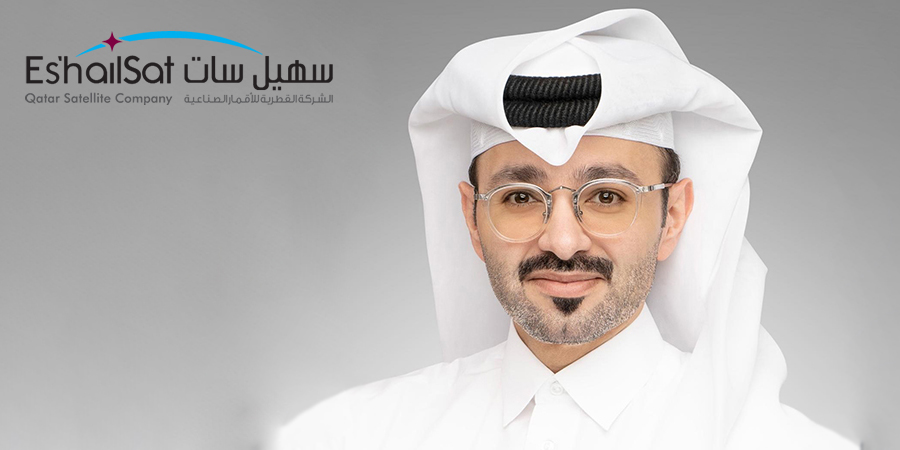In an exclusive interview with Telecom Review, Mohamed Al Sayed, Executive Director – Sales, Es'hailSat, stated that the MENA region holds tremendous potential for expanding connectivity services. Es’hailSat actively contributes to realizing this potential by prioritizing service expansion across all possible satellite services and supporting the rapid growth of Qatari customers.
How does Es'hailSat differentiate itself in the satellite industry, and what competitive advantages does it possess?
With an average fleet age of under 9 years, we at Es’hailSat have one of the youngest fleets of any satellite operator in the Middle East and North Africa region. Our existing satellites, Es’hail-1 and Es’hail-2, co-located at 25.5° east/26° east respectively, are well positioned to serve the needs of broadcast and telecom customers across the board. Coupled with our 50,000 square meter, state-of-the-art teleport facility in Doha, the satellites provide the infrastructure needed for any broadcaster, telco, enterprise or government customer to deliver their services, and allow us to cater to their growing needs.
Our plans are to continually upgrade our capabilities in terms of our teleport, ground segment and managed services to be able to leverage our young fleet in orbit today. Together with our satellites, the strategic location of our teleport in Doha allows us to cover all of the Middle East, North Africa and a large part of the broader EMEA region with our services.
Es'hailSat has been instrumental in revolutionizing the broadcast landscape in the region. Can you expand on the impact of Es'hail-1 and Es'hail-2 on enhancing the coverage and transmission capabilities of broadcasters?
Over the course of the past year, we have added more than 20 new TV channels to our video hotspot across the two satellites. This itself is testament to the fact that customers trust us with their TV channel bouquets and our market share is secured as a result.
Furthermore, we have launched playout and media services to deliver a simple, elegant and one-stop solution to broadcasters that want peace of mind in their operations.
Lastly, via partnerships such as the recent MoU with Nilesat and Total Media Cast (TMC) and others, we are able to serve our customers in regions that are beyond our home country. We can provide them with services that would have originally taken many years for any other company to put together.
Considering the crucial role innovation plays in Es'hailSat's strategy, how does the company incorporate emerging technologies such as satellite constellations, Earth observation analytics, and direct-to-device enabling into its operations?
At this point, the global satellite industry is experiencing an influx of multiple low Earth orbit (LEO) constellations at various stages of their launch, each looking to provide global broadband connectivity. LEO systems are relatively young and unproven, so the recent surge of announcements about new constellations can be seen as a bit of a ‘gold rush.’ While there's a lot of excitement and potential, we think it's important to approach this trend with cautious optimism.
A lot needs to be done before these systems become integrated into the 5G ecosystem and the sheer volume of capital and technological advancements required make it an uphill battle for the companies involved.
Additionally, we are exploring new business models encompassing both Earth observation analytics and direct-to-cell technologies to see where we can provide maximum value to our customers.
5G non-terrestrial networks (NTN) will complement our existing satellite infrastructure and provide a more efficient way to deliver high-speed data and voice services to remote locations. In addition to supporting IoT and M2M applications, they can also provide reliable means of communication in disaster affected areas.
As the demand for satellite services evolves, how does Es'hailSat plan to adapt and expand its capabilities to meet the needs of various sectors such as broadcasters, businesses, and governments?
On the broadcast side, the MENA region has a mix of users who prefer streaming services as well as a healthy number who still want to consume their premium HD content on a smart TV over a satellite DTH service. Due to this underlying demand demographic, we continue to remain bullish in terms of the future of satellite television in the region for many years to come.
On the data side, be it cellular backhaul, or VSAT networking, or even consumer broadband, we have the capabilities to support the companies looking to provide these services across MENA today, and hopefully across the globe very soon.
The MENA region holds tremendous potential for expanding connectivity services given the unique challenges faced by the countries here. While fiber continues to reach the shores of various countries in North Africa, getting the same connectivity inland and overcoming the challenges on-the-ground is a different story altogether.
We are working on multiple long-term projects to fulfil the company’s vision of becoming a world class satellite operator and service provider that effectively contributes to the success of Qatar's National Vision 2030.
What were the milestones of 2023, and what future trends do you foresee in the satellite industry for 2024?
In the past year, we have added playout and media services to our product and services portfolio. These are delivered via our teleport facility in Doha and allow for a hybrid service that can be on premise or cloud based as required by the customer. The fact that we have added more than 20 new TV channels to our video neighborhood is one of our biggest milestones for 2023.
Furthermore, we have also enhanced our satellite news gathering capabilities via our partnership with Total Media Cast (TMC), thereby catering to the many live events taking place in Qatar and in the region.
Our future entails not only being a satellite operator but a service provider, and we see opportunities where we can support our existing (or new) customers with value added services, through partnerships and vertical integration.
For Es’hailSat’s business, the priority over the next 12 months is expanding services across all possible satellite services to support the rapid growth of Qatari customers.
Es’hailSat remains the first choice for companies across the MENA region wherever there is a need for connectivity over satellite.
Continue Reading
Es’hailSat: Revitalizing Satellite Communications in MENA
Es’hailSat, beIN Strengthen Multi-Year, Multi-Transponder Partnership
Strategic Collaboration: Telecom Egypt Joins Forces with Es’hailSat
Check out more on this topic











